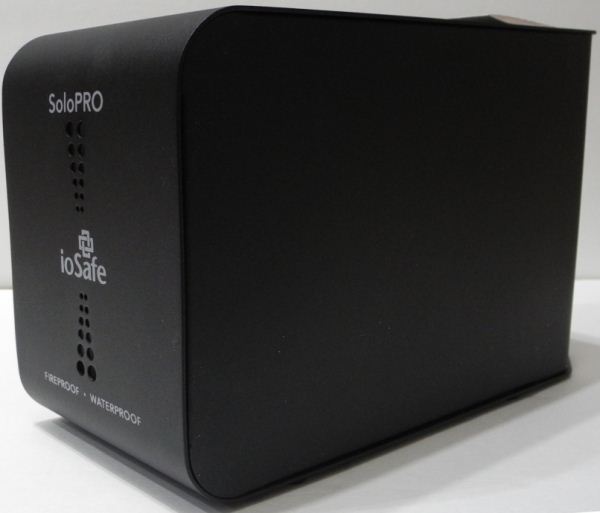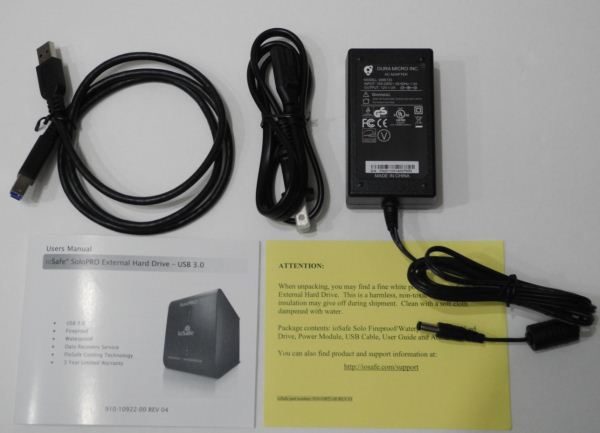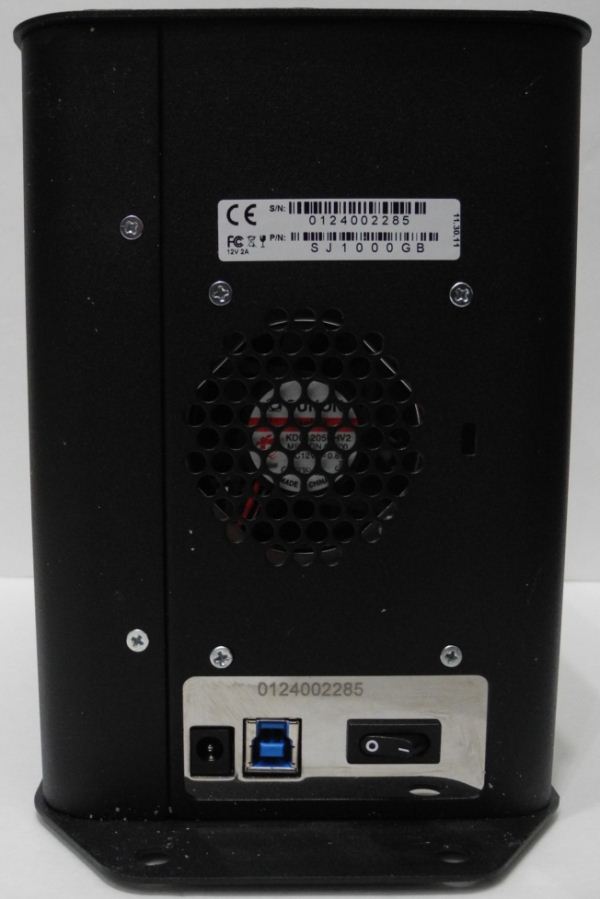ioSafe SoloPRO: Disaster Proofing Your Storage Needs
by Ganesh T S on April 9, 2012 6:00 PM EST- Posted in
- Storage
- IT Computing
- ioSafe
Consumers understand the importance of keeping their documents and other material possessions safe from unexpected disasters. Towards this, many invest in fireproof and waterproof safes. However, as the digital economy grows, many of the possessions such as documents and photo albums are in terms of bits and bytes, rather than tangible things which can be placed in safes. This brings to fore the necessity to find a disaster-proof safe place for those bits and bytes in both personal and business settings.
Storage media (hard disks, in particular) are quite sensitive to environmental conditions, and protecting them from disasters such as fires and floods is an interesting problem. ioSafe has been in the business of selling disaster proof storage solutions for the last 7 years. Their products have been well-reviewed and their CES demonstrations have always drawn a large audience. We received a ioSafe SoloPRO 1TB USB 3.0 version to take out on a test drive. The unit protects data from loss up to 1550°F for 1/2 hour as per ASTM E119 and it is also waterproof upto 10 ft. for 72 hours.
Package Contents and Initial Impressions:
The ioSafe SoloPRO package was surprisingly heavy, coming in at 18 lbs. In addition to the main unit, it came with a 24 W power adapter, a USB 3.0 cable, a user manual and a note about the possibility of fireproof insulation powder being present on the external surface of the unit.
The main unit alone weighed in at a hefty 15.5 lbs. Its dimensions are 5" x 7.1" x 11". The rear side of the main unit has an explicit on-off switch, the USB 3.0 connector and the power inlet. There is also a fan in the unit for active cooling of the hard drive.
On connecting the unit to the computer, we found that the unit internally uses a Seagate Barracuda 7200 rpm 1 TB hard drive with a 32 MB buffer. The USB 3.0 port is provided by JMicron's JMS539 SuperSpeed USB to SATA II 3.0G bridge.
Those are the tangibles in the shipment. What else does one get? The SoloPRO unit comes with a Data Recovery Service (DRS) package, 1 year of which is included in the purchase price. The SoloPRO allows for this to be upgraded to either 3 or 5 years at an extra cost of $50 or $100 respectively. The warranty in the US market is for 3 years, but a 5 year upgrade to DRS automatically extends the warranty to 5 years.
The DRS provides for one instance of no-questions-asked data and hardware recovery. The user mails the affected unit back to ioSafe (shipping paid by ioSafe) and the recovered data is loaded onto another ioSafe unit. In case the data is not recoverable through ioSafe's usual procedures, the company provides upto $2500 in coverage for data recovery by a third party.
Consumers have to explicitly register online with ioSafe for DRS to be enabled on their unit. There is a lot of information (some of which is unnecessary, in our opinion) that needs to be entered while registering. Upon successful registration, one is also provided with a single user license for Genie Timeline Pro, a software to aid in backups (say, to a SoloPRO). The software costs $59.95 when bought standalone, but is complimentary with the purchase of an ioSafe SoloPRO.
The ioSafe SoloPRO 1TB version with USB 3.0 support comes with a MSRP of $349.99, a premium of more than $200 over a comparable non-disaster proof version. What is the technology that is worth this premium? Let us see in the next section.



















34 Comments
View All Comments
ganeshts - Monday, April 9, 2012 - link
Many companies are still paranoid about cloud storage (security and other concerns).Syncing data in real time from the main office to the cloud is also dependent on the bandwidth available.
Yes, the cost is a concern. I am hoping that ioSafe can easily scale up the number of disks without increasing the cost of the enclosure too much.
zanon - Monday, April 9, 2012 - link
Onsite matters for rapid recovery from hardware failure, but in this age I think it's highly questionable for serious disaster recovery. Syncing to your own offsite location (between friends and family for example) offers far more robust protection for nothing beyond the hardware, which not needing to be "disaster proof" per se carries no premium. Good cloud backup is cheap and even more reliable. Encryption means that there are no inherent security issues beyond one's own. A $200 premium will buy more then *5 years* of cloud service for something like CrashPlan+.This seems like an interesting product, but with a pretty niche application of areas that do not have broadband access. Those applications absolutely do exist of course, but it's a shrinking market, and even then it'd still generally be smart to buy some duplicate media and rotate it offsite manually.
robb.moore - Tuesday, April 10, 2012 - link
Hi zanon and cloud surely-Over the years, we've experience numerous disasters with users backing up on nearly 100K ioSafe units . When used in conjunction with our Data Recovery Service, our users are better than 99.9% success of retaining their data - human error, hdd crashes, fires, floods, etc. ioSafe is making a difference in our customer's lives. Much better imo than the 50% of people that have typically lost data.
Our opinion is that the public cloud is great for backing up 20, 30 or maybe even 100GB but it starts to break down after that. It's faster to FedEx a TB across the country than to pipe it over the cloud. If you're a small business, you need to get your business back tomorrow - not next week after all your customers have gone somewhere else.
I have 2TB+ at home on my Synology NAS and CrashPlan, Mozy, etc. simply isn't an option for people in this position as "unlimited" cloud storage is "limited" to data files on a PC and doesn't backup the OS, programs or NAS devices. Rotating media offsite regularly is a pain and I often can't remember to do it. I use a SoloPRO as a backup target for my NAS. With that I get fire, flood, RAID, NAS, "private cloud access" and backup - all without having to install any additional software on my computer.
Disaster proofing terabytes of data, imaging multiple PC OS's, programs, settings, etc. is tough. There's no magic bullet for every situation. ioSafe technology is intended to be used wherever data sits vulnerable and be a simple "disaster plan in a box" solution for data backup and protection.
Combined with cloud and offsite vaulting as you like - ioSafe technology can be layered in wherever vulnerable data exits or your recovery time objective demands.
Great comments - thanks!
-Robb
Robb Moore
CEO
ioSafe
Samus - Thursday, April 12, 2012 - link
Robb, this is great technology. I've been an IT consultant for small business for 10 years and have a number of clients, especially those with small medical practices, that are paranoid about off-site backup solutions. Most of my clients use Carbonite, iDrive, or CTERA without hesitation, but there are a few they just rely on local tape backups or external hard drives that have no fire protection. I try to have clients always keep a rotating tape or hard drive in a fire safe, but there is a lot of room for human error as they can be weeks out of date when someone forgets.I will be trying one of your drives shortly. It's mind boggling you are the first to market something like this when it has been a field waiting to be exploited for 30+ years.
stolid - Monday, April 9, 2012 - link
It seems like it would defeat the purpose if the drive were to fail in a typical manner. This would be cooler if it were two drives within the enclosure in RAID1.robb.moore - Tuesday, April 10, 2012 - link
Thanks stolid-We're constantly working on new products with ioSafe technology - stay tuned!
That being said - the ioSafe SoloPRO is meant as a backup target - not primary storage. At ioSafe we highly recommend that our users follow a minimum of our 3-2-1 Backup Rule:
<> Keep at least 3 complete copies of your data
<> Keep them on at least 2 different devices
<> 1 copy should be on an ioSafe, taken offsite or disaster proofed in someway
Even a RAID 1 device can be accidentally formated or have RAID controller failure causing all the data to be lost. RAID is not "backup". Humans have, many times, pulled the wrong "dead" drive from a RAID 5 array only to discover that the entire array is now corrupt.
Again - just a guideline. Everybody's situation is a little different. Do what makes sense for your data, computer, business, etc.
Thanks!
-Robb
Robb Moore
CEO
ioSafe
P_Dub_S - Monday, April 9, 2012 - link
I have a 1TB Solo and it works great in conjunction with Mozy backup. The server is on a RAID 5 that backs up the entire server locally on the ioSafe incase more than one drive dies or fire/water damage. Then I use Mozy to backup the company data. Very cost efficient backup solution for a small business with under 20 users.robb.moore - Tuesday, April 10, 2012 - link
that's perfect - thanks P_Dub_S. Layering different technologies together to make a disaster recovery plan that works for you is the way to do it.We have 3 ioSafe's go through the Joplin tornadoes. All the offices were destroyed. They recovered all servers the next day.
Tough to do via a pure cloud solution - pushing a pulling TB's of data up and down across an internet connection that's a shredded wire :) The added problem of all the original program disks scattered across the neighboring county!
-Robb
Robb Moore
CEO
ioSafe
zanon - Monday, April 9, 2012 - link
The cloud stuff in this article is really silly.It is not 2005 anymore. Dropbox and the like are general cloud services, not dedicated backup services. Dedicated backup services, like CrashPlan and Carbonite, offer unlimited plans for $3-5 a month. There are even seeding options, wherein they send you a 1TB (or whatever size) drive by mail to start things off for people with slower connections (and vice versa, can pay for a courier service to get data back rather then downloading it). Terabytes of storage is plenty for the vast majority of home users.
After initial replication, obviously backup is incremental. If someone is actually generating many gigs per day in critical new data and has a slow connection, then yes, local is important. I don't think that is describing either most home users or most small businesses, however.
Ridiculous. Serious businesses have real time online backup offsite, if not to multiple offsite locations.
Maybe so, but that's due to either miseducation or stupidity, and Anandtech shouldn't be feeding either. This site should be better then that :\.
ganeshts - Monday, April 9, 2012 - link
zanon, I am sorry you feel that way about my approach to the cloud in this piece.I see your point about Carbonite and CrashPlan, but what is the guarantee that the company won't shut shop suddenly ? Rather than trusting someone with their backups, some people might prefer to have their data close by.
I won't comment on the real time online backup offsite comment, but I do know of companies personally which do an offsite backup once a week (Think in terms of non-IT companies). I do see that ioSafe claims McD, Best Western, Sheraton Group etc. as customers, and I am sure they have their own reasons for choosing ioSafe as their disaster proofing solution.